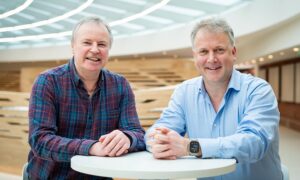
EMBL’s second Kafatos Lecture this Friday
World-renowned structural biologist, Director of the Max Planck Institute of Biochemistry, and EMBL alumna Elena Conti will guide attendees through the fascinating world of the life and death of mRNA.

It’s not too late to register for EMBL’s second annual Kafatos Lecture, which promises to be yet another stimulating talk designed to share molecular biology with the general public.
This year’s lecture,‘Should it stay or should it go: how cells control the life and death of mRNA molecules’, will offer a unique look at the crucial cellular roles that messenger RNA (mRNA) molecules play in transferring genetic information to our bodies’ protein-making machinery. Elena Conti, distinguished biochemist and structural biologist, Director of the Max Planck Institute of Biochemistry, and EMBL alumna, is the perfect guide for this talk that will illuminate what we know about mRNA.
Recognised as a worldwide authority in the study of protein-RNA complexes, Conti – along with EMBL alumna Elisa Izaurralde – was recognised in 2008 with Germany’s most prestigious research award, the Gottfried Wilhelm Leibniz Prize, for ‘fundamental new insights into intracellular RNA transport and RNA’.
We had a chance to catch up with Conti ahead of the lecture to learn more about her work, her background, and why she finds the exploration of RNA supercomplexes and transport both beautiful and challenging.
What is at the heart of the research you are doing these days?
In the past 20 years, a major focus for the laboratory has been to understand how different types of molecular machinery at the atomic level eliminate ‘bad’ mRNAs, such as those resulting from so-called ‘nonsense mutations’ in the DNA. Our extensive efforts in investigating RNA-degrading exosome complexes have finally unveiled how these machineries seamlessly coordinate with ribosomal subunits, in both nuclear and cytoplasmic compartments. We recently started to shift our focus, delving into the mechanisms that protect ‘good’ mRNAs. We are isolating and characterising endogenous mRNA-protein (mRNP) populations in different contexts. The dream is to see the architecture of specific mRNPs throughout their lifecycle.
While this is fundamental science, does your work also inform more applied research?
Learning from fundamental biological processes can translate into clinical applications. If we can understand the mechanisms with which our cells protect their mRNA particles from rapid degradation, one could try and mimic this process with small molecules. Momentum to harness the power of mRNAs as therapeutics undeniably increased during the tumult of the COVID-19 pandemic. Yet, there are aspects that need to be solved to improve therapeutic efficacy, such as increasing the lifetime of mRNAs in our cells. This is where our work on a fundamental level comes into the picture, by understanding nature’s solution to the same issues.
When did you first get interested in science?
I started getting interested in chemistry in high school, thanks to a great teacher and, seemingly, a natural aptitude. When it came time to pick an area of study at university, I was torn between chemistry and architecture. I ended up embarking on the chemistry path, which evolved into biochemistry and eventually into structural biology. This became a passion during my PhD and postdoc and has only grown throughout my career. In a way, I kind of bridged the two interests I was initially torn between, as I ended up studying and unravelling the architecture of macromolecules.
What has been the most challenging and interesting aspect of your work as a structural biologist?
Both the beauty and challenge of studying supercomplexes involved in RNA transport and degradation lie in the many moving parts. Having a parts list is the starting point, but understanding how all the parts come together can be very challenging. In the case of mRNP assemblies, the challenge is probably even greater, as we do not even know the composition of individual mRNA particles, as they dynamically progress through their life cycle. We are very excited to tackle the challenge of visualising the mRNP from birth to the point of translation and decay in light of the insights to be gained by the field.
What scientists have inspired or contributed to your research along the way?
My mentors played an important role in shaping who I am as a scientist, starting from my university days in Italy (Martino Bolognesi) to my PhD in the UK (Peter Brick) to my postdoc in the US (John Kuriyan).
Apart from gaining knowledge in complex technologies, I learned how to methodically get to the heart of a problem, how to follow scientific curiosity with tenacity and resilience, how to stay true to one’s self, and how to follow what the experiments tell you, because the results are not always clear cut and not always what you would have liked them to be. Other scientists in the nucleic acid field – Venki Ramakrishnan, Joan Steitz, and Titia de Lange, to name a few – have always inspired me with their ability to do stellar science yet remain grounded, generous, and active in nurturing the next generation of scientists. This is something I strive to replicate.
When it comes to science communication about RNA or specifically mRNA, what is the bit of reporting you wish the general public had a better understanding of?
For simplicity, RNA in general is quite often taught and illustrated in a linear, one-dimensional fashion. In actuality, when cells make mRNAs, they package them with specific proteins and structure them into compact particles. One can compare this to a long wool thread spooled into a ball, which provides a convenient way of protecting and transporting the wool to the machine that spins it into yarn – or in the cell’s case, translating ribosomes. Conveying the complexity of mRNA particles in a manner that can be grasped by the general public is important, as mRNAs are impacting our lives in major ways.
A few seats remain to attend the Kafatos Lecture in person, to be held on 20 October at 18:00 CEST, at the Museum Mensch und Natur, Schloss Nymphenburg, in Munich. Conti’s talk is titled, ‘Should it stay or should it go: how cells control the life and death of mRNA molecules’. Register here to attend in person, or tune in virtually with this link for the talk.
The Kafatos Lecture series was launched in 2021 to honour the considerable legacy of Fotis Kafatos, former EMBL Director General and Founder and first President of the European Research Council (ERC). This lecture series aims to bring groundbreaking and relevant life science research to the worldwide public, making it accessible and highlighting its day-to-day societal impact.
This lecture is made possible thanks to the generous support from the Bodossaki Foundation, one of the largest privately owned public-benefit organisations in Greece.


